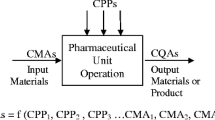Abstract
Some drugs are intended for sequential storage under two different storage conditions. If the data for each condition are analyzed separately, predicting assay and other responses after T1 months at one condition followed by T2 months at the other condition is non-trivial for several reasons. First, the two analyses will give different intercept terms. What should one do about that? Second, how would one calculate the confidence limits for combined storage? Third, what if prior storage at one condition affects the slope at the other condition? This paper proposes a simple ANCOVA model containing two slope terms, one for each storage condition. When multiple batches and/or packages are involved, it is easily generalized to two sets of slope terms. Confidence limits are straightforward and can be calculated using existing commercial software. With properly designed data, one can test whether prior storage at one condition affects the slope at the other condition. If no such effect is significant, very useful extrapolations can be made. Temperature excursions, model reduction and curvilinear dependencies are discussed.


Similar content being viewed by others
Notes
“Worst” is defined as the combination with the highest upper confidence limit at that particular time point. This is slightly more conservative than choosing the upper confidence limit for the worst combination at the target shelf life, but the worst combination can vary with time point, and target shelf lives can change. When two-sided limits are involved, there are two worst combinations, one with the highest upper and one with the lowest lower confidence limit.
REFERENCES
Box GEP, Hunter WG, Hunter JS. Statistics for experimenters. New York: Wiley; 1978. Chapter 14.
ICH Guidance for Industry. Q1E evaluation of stability data. Food and Drug Administration, 2004. http://www.fda.gov/RegulatoryInformation/Guidances/ucm128092.htm. Accessed 10 June 2010
Neter J, Wasserman W, Kutner MH. Applied linear statistical models, 2nd edn. In: Irwin RD, editor. Chapter 10. Chicago: Homewood; 1985.
Tsong Y, Chen WJ, Chen CW. ANCOVA approach for shelf life analysis of stability study of multiple factor designs. J Biopharm Stat. 2003;13:375–93. doi:10.1081/BIP-120022761 Accessed 11 Dec 2010.
SAS Institute. JMP statistics and graphics guide release 6. Cary: SAS; 2005. p. 862–3.
Draper NR, Smith H. Applied regression analysis. 2nd ed. New York: Wiley; 1981. p. 246.
Nelder JA. The selection of terms in response-surface models—how strong is the weak-heredity principle? Am Stat. 1998;52:315–8. http://www.jstor.org/pss/2685433. Accessed 10 June 2010.
Peixoto JL. Hierarchical variable selection in polynomial regression models. Am Stat. 1987;41:311–3. http://www.jstor.org/pss/2684752. Accessed 10 June 2010.
Peixoto JL. A property of well-formulated polynomial regression models. Am Stat. 1990;44:26–30. http://www.jstor.org/pss/2684952. Accessed 10 June 2010.
Porter WR. Solid state degradation mechanisms: impact on drug product design and stability test design. Presented at the 33rd Annual Midwest Biopharmaceutical Statistics Workshop, 25 May 2010, Muncie, IN. http://www.mbswonline.com/presentationyear.php?year=2010. Accessed 22 June 2010.
Carella, AJ. Accelerated stability assessment program for packaged solid dosage forms. Presented at the 33rd Annual Midwest Biopharmaceutical Statistics Workshop, 25 May 2010, Muncie, IN. http://www.mbswonline.com/presentationyear.php?year=2010. Accessed 22 June 2010.
Murphy JR, Hofer J. Establishing shelf life, expiry limits, and release limits. Drug Inf J. 2002;36:769–81.
Shao J, Chen L. Prediction bounds for random shelf-lives. Stat Med. 1997;16:1167–73. doi:10.1002/(SICI)1097-0258(19970530)16:10<1167::AID-SIM524>3.0.CO;2-5 Accessed 15 December 2010.
Quinlan W, Schwenke J, Stroup W. Direct approach to shelf life estimation. Poster presentation at the 31st Annual Midwest Biopharmaceutical Statistics Workshop 5/19-21/08, Muncie IN. http://www.pqri.org/commworking/minutes/pdfs/dptc/sslwg/Addl/Quinlan_-_Poster_-_Shelf_Life_Estimation.pdf Accessed 10 June 2010.
Schwenke J. Reconsidering shelf life: an update from the PQRI Stability Shelf Life Working Group, Presentation at 31st Annual Midwest Biopharmaceutical Statistics Workshop. 19–21 May 2008, Muncie, IN.
Shao J, Chow SC. Two-phase shelf-life estimation. Stat Med. 2001;20:1239–48. doi:10.1002/sim.783 Accessed 11 Dec 2010.
Chow SC, Shao J. Statistics in drug research: methodologies and recent developments. In: Chapter 4.4. London: CRC Press; 2002.
ACKNOWLEDGEMENTS
James S. Bergum is thanked for the excellent mentorship during the first author’s tenure at Bristol-Myers Squibb. MannKind Corporation is thanked for permission to publish. The reviewers are thanked for the many valuable suggestions. One reviewer is particularly thanked for his “eagle eye.”
Author information
Authors and Affiliations
Corresponding author
Electronic Supplementary Materials
Below is the link to the electronic supplementary material.
Supplementary File 1
(XLS 108 kb)
Supplementary File 2
(JMP 55 kb)
Rights and permissions
About this article
Cite this article
Friedman, E.M., Shum, S.C. Stability Models for Sequential Storage. AAPS PharmSciTech 12, 96–103 (2011). https://doi.org/10.1208/s12249-010-9558-x
Received:
Accepted:
Published:
Issue Date:
DOI: https://doi.org/10.1208/s12249-010-9558-x




